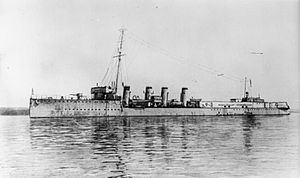HMS Abdiel (1915)

HMS Abdiel fitted as a minesweeper. The aft end of the ship is screened off with canvas to conceal the minelaying equipment
|
|
| History | |
|---|---|
|
|
|
| Name: | HMS Abdiel |
| Builder: | Cammell Laird, Birkenhead |
| Laid down: | 6 May 1915 |
| Launched: | 12 October 1915 |
| Commissioned: | 26 March 1916 |
| Honours and awards: |
Jutland 1916 |
| Fate: | Sold for scrap July 1936 |
| General characteristics | |
| Class and type: | Marksman-class flotilla leader |
| Displacement: |
|
| Length: | 324 ft 10 in (99.01 m) (overall) |
| Beam: | 31 ft 9 in (9.68 m) |
| Draught: | 12 ft (3.66 m) |
| Propulsion: |
|
| Speed: | 34 kn (63 km/h; 39 mph) |
| Range: | 4,290 nmi (7,950 km; 4,940 mi) at 15 knots (28 km/h; 17 mph) |
| Complement: | 104 |
| Armament: |
|
HMS Abdiel was a Marksman-class flotilla leader of the Royal Navy, built by Cammell Laird during the First World War. She was converted to a minelayer during construction, commissioning during 1916, and served at the Battle of Jutland. Following the end of the war, Abdiel served in the Baltic during the Russian Civil War. She was sold for scrap in 1936.
In November 1914, as part of the Emergency War Programme of shipbuilding, the British Admiralty ordered three Marksman-class flotilla leaders (i.e. large destroyers intended to lead flotillas of smaller destroyers in action) from the Birkenhead shipyard Cammell Laird. The third of these three ships, HMS Abdiel (originally to be named Ithuriel) was laid down on 6 May 1915 and was launched on 12 October 1915.
The Marksman-class ships were 324 feet 10 inches (99.01 m) long overall, 324 feet (99 m) at the waterline and 315 feet 0 inches (96.01 m) between perpendiculars. They had a beam of 31 feet 9 inches (9.68 m) and a draught of 12 feet 0 inches (3.66 m). The design displacement was 1,440 long tons (1,460 t) normal and 1,700 long tons (1,700 t) full load.Abdiel was propelled by three sets of Parsons steam turbines, fed by four Yarrow three-drum boilers, rated at 36,000 shaft horsepower (27,000 kW), which gave a speed of 34 knots (63 km/h; 39 mph). Four funnels were fitted. Up to 515 tons of oil fuel could be carried, giving a range of 4,290 nautical miles (7,950 km; 4,940 mi) at 15 knots (28 km/h; 17 mph). The ship's crew was 104 officers and men.
...
Wikipedia
